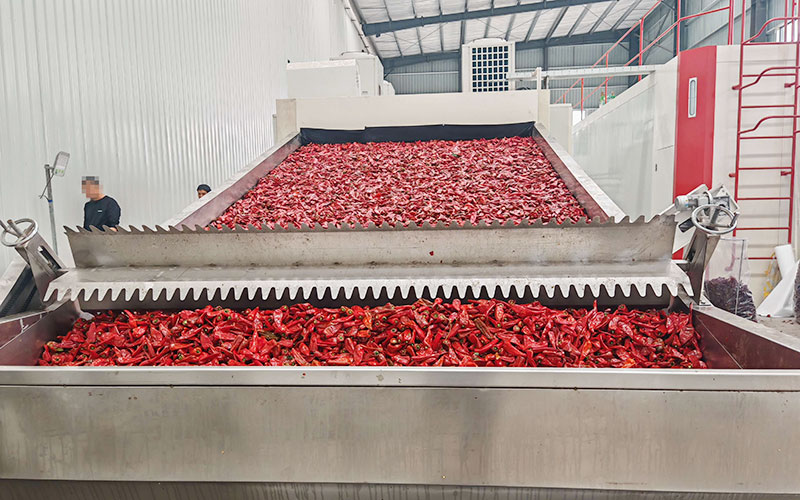Red chillies lose up to 30% of their market value due to poor drying—mold, discoloration, or capsaicin degradation. For exporters in India’s Guntur or Mexico’s Yucatán, precision drying isn’t optional—it’s profitability. This guide explores how modern red chilli drying machine (belt dryers) transforms this high-stakes process while preserving the fiery soul of your harvest.
Why Red Chillies Demand Specialized Drying
Red chillies possess three traits that make conventional drying risky:
Capsaicin Sensitivity: Heat exceeding 65°C breaks down this heat-giving compound, dulling flavor and potency.
Thin Epidermis: Fragile skin cracks under rapid moisture loss, inviting mold (Aspergillus spp.) and spoilage.
Color Vulnerability: Lycopene and carotenoids fade if humidity isn’t staged—turning vibrant red into dull brown.
Traditional sun drying fails here: 18% of Mexican Jalapeños develop “sun scald” spots, while Thai bird’s eye chillies lose 40% capsaicin in open-air drying.
How Belt Dryers Work: Precision Meets Scalability
A red chilli drying machine uses multi-tiered stainless steel mesh belts (3–7 layers) to automate the three drying phases:
Preheating Zone (45–50°C): Gentle heat prepares cell walls for moisture release without shock. Critical for thick-walled varieties like Byadgi (India).
Uniform Drying Zone (55–60°C): 80% moisture removal occurs here. Cross-flow hot air penetrates chilli layers vertically, with humidity sensors auto-adjusting exhaust.
Final Conditioning (50°C): Slow drying prevents case-hardening—where outer layers crust, trapping internal moisture. Belt speed drops 30% here.
PLC systems log real-time data: “In Tamil Nadu farms, we maintain 58°C±1°C and 12% RH for Guntur Sannam—color retention improved by 70%”.

What Are The Problem In The Red Chilli Drying Process All Over The World & Solutions
🇮🇳 India: Namaste! For Byadgi or Kashmiri Chillies
Challenge: Monsoon humidity spikes (≥85% RH) demand rapid drying to prevent aflatoxins.
Solution: 5-layer belt dryers with dehumidifier backup cut drying time to 16 hours (vs. 72 hours sun drying). Output: >95% whole chillies, ISO 5554 compliance.
🇲🇽 Mexico: ¡Hola! For Jalapeños or Anchos
Challenge: Flesh thickness (3–4mm) requires longer drying at lower temps to avoid “pocket steaming” (internal rot).
Solution: Extended conditioning zones (8–10m belt length) with step-down temperature control. Fuel: Solar-hybrid heat pumps slash costs by 60%.
🇹🇭 Thailand: Sawasdee! For Bird’s Eye Chillies
Challenge: Small size (2–3cm) increases surface-area exposure—risk of over-drying.
Solution: Low-velocity airflow (<1.5m/s) and intermittent tumbling prevent brittleness. Result: 98% capsaicin retention—critical for extract industries.
Why Belt Dryers Dominate
🔥 Features
SUS304 Stainless Steel Mesh & Zoned Microclimate Control
Advantage: Resists capsaicin corrosion; isolates temperature/humidity per zone.
Hybrid Energy Flexibility (Heat Pump/Solar/Biomass)
Advantage: Swaps fossil fuels for renewables without retrofitting.
Moisture sensors auto-halt drying at 8–10% (optimal for grinding/export).
💡Benefit
Saves $11/ton in Punjab—ROI in 14 months.
Zero over-drying waste—yield up by 18%.
<3% breakage rate vs. 15–20% in tray dryers. Colour scores consistently >150 ASTA.
📊 Evidence
Mexican secadoras using smart dryers boosted exports to EU by 30%;
Gujarat cooperative’s solar-assisted dryer cut CO2 by 320 tons/year;
Third-party tests on Andhra Sannam: 99.2% mold-free after 12-month storage;
Technical Specifications: Belt Dryer Performance Benchmarks
| Parameter | Entry-Level | Mid-Range | Industrial |
|---|---|---|---|
| Capacity (per 24h) | 1–2 tons | 5–10 tons | 20–80 tons8 |
| Belt Layers | 3 | 5 | 7 |
| Power Source | Electric | Biomass | Steam/Heat pump |
| Drying Time | 18–24h | 14–18h | 10–14h4 |
| Moisture Reduction | 80%→8% | 80%→8% | 80%→8% |
Conclusion: Make “Red Gold” Worth Its Weight
A red chilli drying machine isn’t just equipment—it’s your gateway to global spice markets. By harmonizing tradition with technology, it protects what matters: heat, hue, and harvest value.
🌶️ Claim Your Free Drying Protocol Template!
Download Now: Customized for your chilli variety (Ancho, Kashmiri, Bird’s Eye, etc.)—includes temperature charts and humidity settings.
Schedule a Live Demo: Watch our belt dryer process 500kg of Ghanaian Kpakposhito chillies in real-time via factory cam.
✉️ Get Expert Advice Today: Message us for:
Energy-Cost Calculator: Compare fuel options (coal vs. biomass vs. electric).




